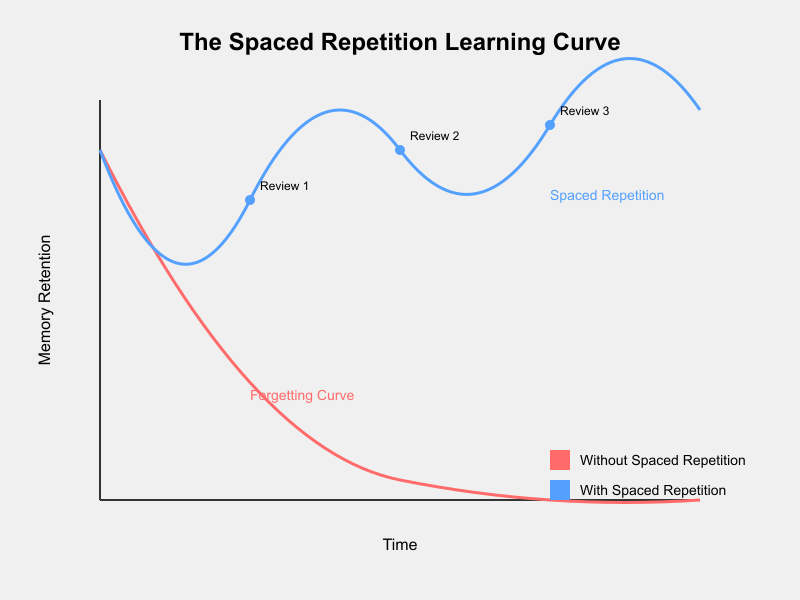Picture this: It’s the night before a crucial exam. You’re hunched over your desk, surrounded by stacks of notes, desperately trying to cram every bit of information into your brain. The next morning, you stumble into the exam room, bleary-eyed and anxious, only to find that half of what you studied has vanished from your memory. Sound familiar?
We’ve all been there, wrestling with the frustration of forgotten information. But what if I told you there’s a better way? A method that helps you retain more knowledge with less effort? Enter the world of spaced repetition – a learning technique that’s not just effective, but backed by science.
The Magic of Spaced Repetition
Spaced repetition is like a workout routine for your brain. Instead of lifting heavy weights all at once (cramming), you spread out your “reps” over time. You review information at increasing intervals, reinforcing your memory just when you’re about to forget it. It’s simple, yet incredibly powerful.
I first stumbled upon this concept when I was struggling to learn a new language. No matter how many hours I spent studying vocabulary, the words seemed to slip away faster than I could learn them. That’s when I discovered spaced repetition, and it changed everything.
The Science: Why It Works
Let’s dive into the fascinating science behind this technique. Back in the late 19th century, a German psychologist named Hermann Ebbinghaus made a groundbreaking discovery. He found that we forget about 60% of what we learn within 24 hours if we don’t review it. This rapid decline in memory is known as the “forgetting curve.”
But here’s the exciting part: Ebbinghaus also discovered that we can combat this forgetting curve by revisiting information at specific intervals. Each time we review something, our memory of it becomes stronger and lasts longer.
This is where spaced repetition comes in. By spacing out our review sessions, we’re essentially training our brains to hold onto information for longer periods. It’s like building mental muscle memory.

The Forgetting Curve: Your Brain’s Natural Enemy
To truly appreciate the power of spaced repetition, we need to understand our brain’s natural tendency to forget. The forgetting curve isn’t just a theory – it’s a reality we all face every day.
Imagine you’ve just learned a new concept. In the first hour, you remember it clearly. But as time passes, your recall starts to fade. By the next day, you might only remember half of what you learned. A week later, even less.
This isn’t a flaw in our memory – it’s a feature. Our brains are designed to prioritize new, relevant information and let go of what it deems unnecessary. The problem arises when we need to retain information for the long term, like when studying for exams or learning a new skill.
Spaced repetition works by interrupting this natural forgetting process. By reviewing information just as we’re about to forget it, we reset the forgetting curve and strengthen our memory. It’s like catching a ball just before it hits the ground – with each catch, we extend its flight time.
How to Use Spaced Repetition: A Step-by-Step Guide
Ready to give spaced repetition a try? Here’s how you can get started:
- Choose Your Material: Pick what you want to learn. It could be anything from French vocabulary to historical dates.
- Create Flashcards: Use digital tools like Anki or Quizlet, or go old-school with paper cards. Write a question on one side and the answer on the other.
- Set Up Your Schedule: This is crucial. Review your cards after 1 day, then 3 days, then a week, then two weeks, and so on. The intervals should increase as you remember the information more easily.
- Review and Adjust: As you go through your cards, mark the ones you find difficult. These should be reviewed more frequently than the ones you find easy.
- Be Consistent: Regular practice is key. Set reminders if you need to, but stick to your schedule.
I remember when I first started using this method to learn Spanish. At first, it felt strange to deliberately wait before reviewing words I had just learned. But after a few weeks, I was amazed at how much more I could remember compared to my old cramming methods.
The Spaced Repetition Revolution: Beyond Flashcards
While flashcards are a popular way to implement spaced repetition, they’re not the only option. The principles of spaced repetition can be applied to various learning methods:
- Concept Mapping: Create visual representations of concepts and review them at increasing intervals.
- Practice Problems: For subjects like math or physics, solve problems related to specific concepts at spaced intervals.
- Teaching Others: Explaining concepts to others at spaced intervals can reinforce your own understanding.
- Writing Summaries: Summarize key points from your studies, then review and expand on these summaries over time.
- Real-world Application: Find ways to apply what you’re learning in practical situations, spacing out these applications over time.
The key is to find a method that works for you and stick with it. Remember, consistency is more important than perfection.
Real-World Success Stories
Spaced repetition isn’t just for language learners or students. It’s a tool used by professionals across various fields to master their craft. Take Dr. Michael Nielsen, a neuroscientist who used spaced repetition to memorize thousands of medical facts. He reported significant improvements in his exam performance and clinical practice.
Or consider the story of Gabriel Wyner, an opera singer who used spaced repetition to become fluent in multiple languages in record time. He went from speaking only English to mastering French, German, and Italian in just a few years.
These stories aren’t exceptions – they’re examples of what’s possible when you leverage the power of spaced repetition.

Overcoming Common Pitfalls
Like any learning technique, spaced repetition comes with its challenges. Here are some I’ve encountered and how to overcome them:
- Inconsistency: It’s easy to fall off the wagon. Combat this by setting daily reminders and treating your review sessions as non-negotiable appointments with yourself.
- Overambition: Don’t try to learn everything at once. Start small, maybe with 10-20 flashcards a day, and gradually increase as you get comfortable with the system.
- Neglecting Difficult Material: It’s tempting to focus on what you already know. Make a conscious effort to spend extra time on challenging concepts.
- Passive Review: Simply glancing at flashcards isn’t enough. Engage actively with the material by explaining concepts in your own words or finding real-world applications.
- Ignoring the Why: Understanding why you’re learning something can boost motivation. Connect your learning goals to your broader life objectives.
The Future of Learning: Spaced Repetition and Technology
As we look to the future, the potential of spaced repetition is only growing. With advances in artificial intelligence and machine learning, we’re seeing the development of adaptive learning systems that can personalize spaced repetition schedules based on individual learning patterns.
Imagine a learning app that knows exactly when you need to review a concept, adjusting in real-time based on your performance. Or virtual reality environments that immerse you in spaced repetition exercises, making learning feel like a game.
While these technologies are exciting, remember that the core principle remains the same: consistent, spaced review is key to long-term retention.
Wrapping Up: Your Brain’s New Best Friend
Spaced repetition isn’t just another study hack – it’s a fundamental shift in how we approach learning. By aligning our study habits with how our brains naturally process and store information, we can achieve remarkable results with less effort.
So the next time you’re faced with a learning challenge, remember: it’s not about studying harder, it’s about studying smarter. Give spaced repetition a try, and watch as your ability to retain information transforms.
Are you ready to revolutionize your learning? Start small, be consistent, and trust the process. Your future self will thank you for the knowledge you’re about to gain – and keep.
Happy learning!
